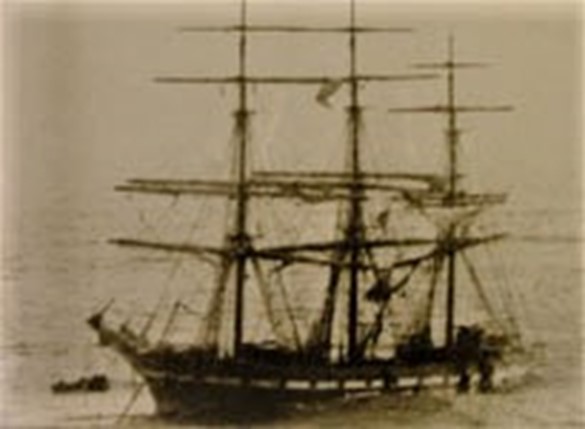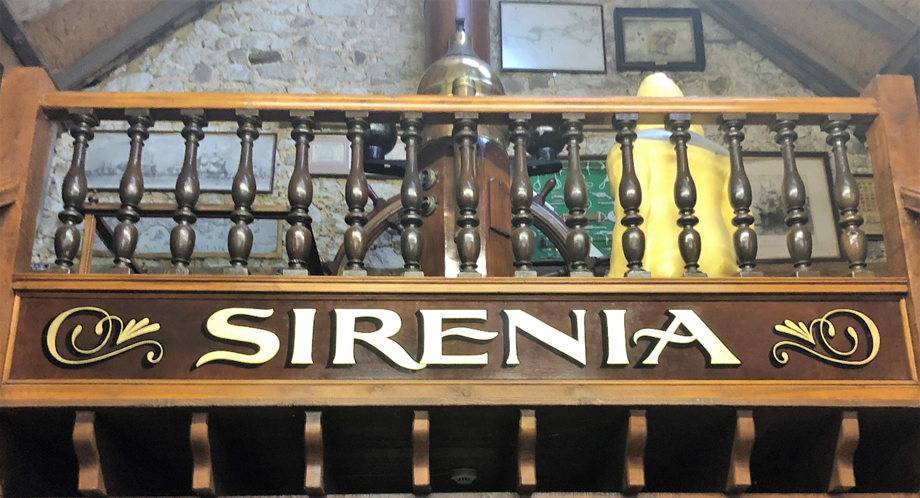Another shipwreck in a notorious location and the consequences of a difficult rescue. Volunteer Roger Burns relates the story of the loss of the Sailing Vessel Sirenia on the Atherfield Ledge, Isle of Wight, a rescue with tragic consequences, leading to an increased RNLI presence on this part of the coast.
Location
The Atherfield Ledge is a rocky, mostly underwater, outcrop on the south west of the Isle of Wight. The outcrop is only about half a mile square, but projects into the sea and has claimed at least 46 wrecks, mostly in the 18th and 19th centuries, which included a variety of wooden, iron and steel hulled vessels ranging from small sailing vessels to larger steamers. The prevailing winds have caused ships to be embayed, but several losses were due to navigational errors in fog obscuring the land, and these conditions have resulted in Atherfield Ledge being one of the principal shipwreck areas around the Isle of Wight.
The Sirenia

Figure 1: The Sailing Vessel Sirenia aground at Atherfield Ledge
Source: Courtesy of and attributed to Brighstone Village Museum
The Sirenia, Figure 1, was a 3-masted general cargo sailing vessel built by Charles Connell & Company in their Scotstoun yard at Whiteinch, Glasgow. Launched on 8 December 1885 for Robert McMillan, Methlan Park, Dumbarton, it was steel hulled, registered with ON90096 at Glasgow on 20 January 1886, had a length of 80.71m, beam of 11.61m, and internal depth of 6.89m.
A January 1886 Lloyd’s report refers to it being “Ship Rigged” with steel spars, two steel decks and one bulkhead. The ship, provided with two lifeboats and two other boats, was Lloyd’s classified 100A1 for its first voyage.
Intended when launched to be used on the Glasgow and Indian trade, the first voyage was to Calcutta arriving 22 May 1886, departing on 4 September 1886 to London, arriving 18 January 1887. At some point, possibly when moved between docks in London, it may have grounded as it was transferred to drydock for examination and repainting of its bottom. The second voyage was to San Francisco arriving 31 July 1887.
The Loss, Rescue and Fatalities
The Sirenia departed San Francisco with a cargo of 2,592 tons of wheat on 27 September 1887 with twenty-seven crew including the captain, plus his wife, their three children and a maid. It was bound for either Cork, UK, Havre or Antwerp via Cape Horn according to orders it would receive at Queenstown on 29 February 1888. It was 7 March before the Sirenia departed Queenstown for Dunkirk and just two days later on 9 March 1888, it was aground on the rocks at Atherfield Ledge.
Contemporary and some later accounts of the wrecking and rescue details are inconsistent although with a similar theme; however, the transcript from Lloyd’s List report of Wednesday 14 March 1888 presents a fair summary:
‘SIRENlA—Report of Duncan Mclntyre, master of the ship Sirenia, of Glasgow:……Proceeded, and all went well until we were off the Isle of Wight. On March 9, about 2 p.m., tide last quarter ebb, weather thick, wind W.S.W., a moderate gale, with a heavy sea from the W.S.W., the vessel struck Atherfield Ledge, Isle of Wight…….. We kept sail on and the vessel kept bumping for some time. Let go starboard anchor to try and get her head off, but did not succeed. Subsequently let go port anchor, but finding the vessel could not be saved, the sails were made fast, the windlass eased up, and the crew ceased to work. The Brighstone lifeboat reached the vessel about 5 p.m. and took off deponent’s wife, three children, a maid, and an apprentice. About 2 a.m. on the 10th the lifeboat again reached the vessel and saved 12 hands. On its way to the shore it capsized, and I am informed that two of my crew and two of the boat’s crew were drowned. The boat was again launched in the afternoon and saved deponent and the remainder of the crew. — Atherfield, March 10’.
An inquest was held at the Five Bells Inn at Brighstone on 12 March 1888 and extracts from Lloyd’s List of 14 March are included in the following summary of the rescue efforts:
First on scene, at 14.30, was a Pilot cutter from Deal, the SV Renown, captain Pearson, offering help but none was actually given. The Brighstone lifeboat, the Worcester Cadet was on scene at 17.00. Moses Munt was the first coxswain, Thomas Cotton the second coxswain, and, manned by another 11 men, the Worcester Cadet took the first six safely to shore. The weather worsened delaying the return trip to the Sirenia, until just after midnight. Taking a further 13 from the Sirenia, the maximum capacity of the lifeboat, they noticed the light from the Brooke lifeboat, the William Slaney Lewis, and setting out for the shore, were caught broadside as they turned by a cross sea, capsizing the boat and throwing all on board into the sea. Munt and Cotton were lost as were two of Sirenia’s crew, but the others, totally exhausted regained the lifeboat and reached shore. As the Worcester Cadet was returning the second time, the body of able seaman Leonard Dozier, aged 24 years, who had joined the Sirenia at San Francisco, was found tangled overboard in the lifeboat ropes as a consequence of the capsize. The other crewman lost was Thomas Maybery, aged 17 years, apprentice, from Plymouth, but he had joined the Sirenia in London. Then the lifeboat again returned and took off the remaining crew including the captain.
The William Slaney lifeboat on its maiden voyage whose light had been observed by the Worcester Cadet, had been swamped, losing their assistant coxswain, Reuben Cooper, and were forced to drop anchor and ride out the weather, remaining at sea cold and wet, until dawn when they were able to return to shore. Cooper’s death was recorded as an accidental drowning.
A body, thought to be that of Thomas, was found by a local fisherman some nine months later, badly dismembered and decomposed, near Ladder Chine, not far south east of Atherfield.
Post Loss Actions and Outcomes
At least three vessels and some barges were involved in salvage, and being small made it easier to get nearer the Sirenia. Some of the wheat was salvaged, as was a good portion of the fittings, and all were auctioned on the Isle of Wight and at Southampton between late March and July. In late July, part of Sirenia’s deck came ashore at Rocken, and in mid-September 1888, the PS Brodick Castle, an iron hulled passenger excursion paddle steamer, was on a round the island pleasure cruise, when the masts of the Sirenia were still visible. There are no discernible remains above the water now.

Figure 2: The Sirenia’s Nameboard
Displayed on a balcony of the Shipwreck Centre and Maritime Museum
The Sirenia’s nameplate, Figure 2, was recovered and is now displayed in the Shipwreck Centre and Maritime Museum at Arreton Barns, Isle of Wight. Two other artefacts were reported to the Receiver of Wreck in 2001 and 2002 respectively, a 6″ (c.15cm) floor tile from the wreck, and a wooden block said to have come from the wreck, discovered along the south coast of the Island.
The RNLI conducted their own enquiry and concluded that no-one was to blame for the loss of life, and commended the lifeboat crews for their actions. The RNLI awarded Silver Medals of the Institution to William Cotton, Frank Slater and David Cotton.. Formal thanks of the Institution inscribed on vellum were awarded to Mr. George Sweetingham, Chief Officer, and to Mr. William Brett, Chief Boatman in charge of H.M. Coast-guard at Atherfield, in recognition of their valuable services on the occasion.
The Hampshire Independent of 20 October 1888 reported that the public had responded splendidly to a Lifeboat Disaster fund, totalling £1,223, 15s, 2d (approx. £125k in 2022). The list of contributors covered 1½ columns and provision was made for the sister of Rueben Cooper, the Brooke lifeboat assistant coxswain, and for tombstones with suitable inscriptions to be erected at St. Mary’s church, Brighstone to Moses Munt, coxswain, Thomas Cotton, assistant coxswain of the Brighstone lifeboat, and Leonard Proctor Dozier, the young American crewman from the Sirenia.
In February 1889, the local lifeboat committee received an extremely touching letter from the mother of Leonard Dozier, in which she wrote just prior to Christmas about the kindness of English lifeboat crew and friends in arranging for a headstone to be placed above her son’s grave.
The loss of three RNLI crew, and the history of wrecks at Atherfield Ledge, led to another lifeboat station on this stretch of coast. The RNLI had been bequeathed £700 (approx. £72k in 2022) by Mrs. Catherine Swift, late of Lowcliffe, Chale, near Atherfield, for the provision of a lifeboat at Atherfield. The cliffs at this location necessitated a corrugated boathouse at the top of the cliff, the boat being launched by a rope-controlled 1-in-3 steep ramp of flat skids, some 75m long, and pulled back up by winch. The new Lifeboat was named the Catherine Swift, and became operational on 27 October 1890.
Another recognition of the human losses can be found in a song by the Brighstone Barnacles, and the words of the chorus are on the gravestone of Moses Munt:
A few more rolling suns at most,
Will land us on fair Canaan’s coast
Then we shall sing the song of grace,
And see our Saviour face to face.
Other Atherfield Ledge shipwrecks include SV Dizzy Dunlop, SV Alcester, and SV Auguste.

George Thomas Sweetingham, the Chief Coastgurad at Atherfield, was my Great Grandfather and I am proud to own the inscribed vellum referred to.
He was also presented a Testimonial and inscribed silver tea and coffee service for his involvement with the rescue of the crew of the ‘Atlas’ which fell victim to the Atherfield Ledge on November the 25th, 1880.